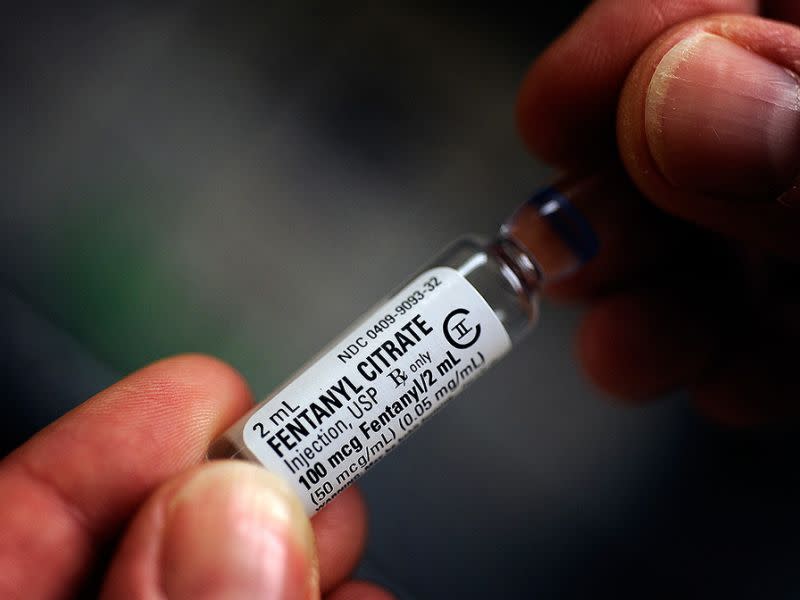All About Fentanyl, the Drug that Killed Prince and Is Sweeping the U.S.
Prince’s April 21 death has now been officially chalked up to an overdose of the opiate fentanyl.
But fentanyl may not be as immediately familiar to many people as more commonly cited drugs like Percocet or Oxycontin. Here’s the low-down on the drug.
Fentanyl is a synthetic opiate similar to morphine, but much more powerful. The CDC estimates that fentanyl is 80 times as potent as morphine and hundreds of times more potent than heroin. Classified as a Schedule II drug by the federal government, its medical uses are typically pain management following surgery or for chronic pain.
Now marketed under the brand names Actiq, Duragesic and Sublimaze, Fentanyl was originally synthesized by Paul Janssen in 1959 or 1960 (reports vary) as a structurally related analog for pethidine (more commonly known as Demerol), which had been created a few years prior.
Fentanyl was being abused recreationally by the 1970s. Apparently, it’s appeared on the streets under names like: Apache, China Girl, China White, Dance Fever, Goodfella, Jackpot, Murder 8, TNT and bizarrely, Tango and Cash. While initially, it was simply stolen from pharmacies, it has also been synthesized by drug dealers and is frequently “cut” or mixed with heroin or cocaine, going by ominous names like Bomb, Drop Dead, Flatline and Lethal Injection. One gram of pure fentanyl can be cut into approximately 7,000 doses for street sale, and manufacture of the drug requires relatively little technical knowledge.

The DEA occasionally discovered illicit fentanyl labs in the 1980s and 1990s, but it was in the 2000s that the drug’s appearance on the street increased markedly. The CDC reports that from 2005-2007, there were a total of 1,013 deaths related to fentanyl in the U.S., most of which were concentrated in Illinois and Michigan. In the early ‘00s, the drug also flooded Eastern Europe, where, in a dark foreshadowing of its place in the U.S., it overtook heroin as the hard drug of choice. Estonia was hit particularly hard; at one point, the drug was killing more people than traffic accidents.
More recently, in 2013, a previously unseen fentanyl analog was blamed for 14 overdose deaths among drug users in Rhode Island. In most of the cases, the drug was, as usual, mixed with cocaine, heroin or other drugs. In August 2015, a spate of overdoses in Western Canada were linked to the drug, which was being trafficked along a common drug route that flowed from British Columbia to Alberta and Vancouver. Canadian authorities have linked 500 deaths to the drug since 2013.
In the U.S., fentanyl has quietly usurped heroin in many regions. In New Hampshire, for example, the drug killed 158 people in 2015, while heroin killed 32.

“It started out as an opioid epidemic, then heroin, but now it’s a fentanyl epidemic,” Maura Healey, the attorney general of Massachusetts, told the New York Times in March. “Massachusetts is the epicenter for the heroin/fentanyl trade,” Healey added. “From Lawrence, it’s being trafficked and sold all over the New England states.”
In March of 2015, the DEA issued a nationwide alert about the drug. “Drug incidents and overdoses related to fentanyl are occurring at an alarming rate throughout the United States and represent a significant threat to public health and safety,” DEA Administrator Michele M. Leonhart wrote. The report specified New Hampshire, New Jersey, Rhode Island, Pennsylvania and the St. Louis area as being hit particularly hard, with California one West Coast outlier, owing to its common use as a traffic route for drug cartels in Mexico.
The alert did not come without solid cause, as Levenson told PEOPLE that America is facing a “national opioid epidemic, with overdose being the number one cause of accidental deaths in the country.
“Ultimately, you end up with overdoses and fatalities because of tolerance. They’re not getting the effect so they take more and more and more, but there’s a point when more is deadly,” he said. “Long term Fentanyl use leads to death.”

